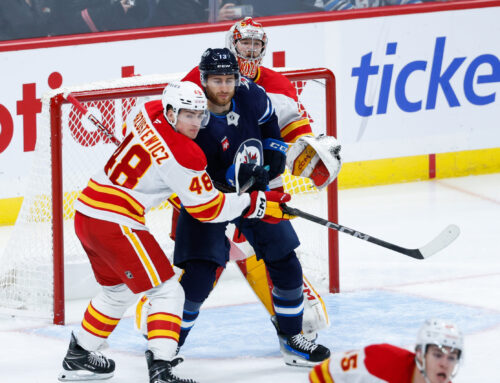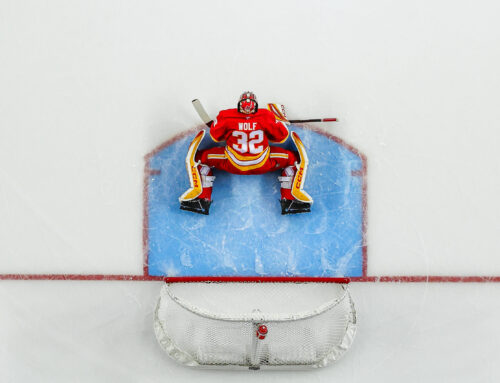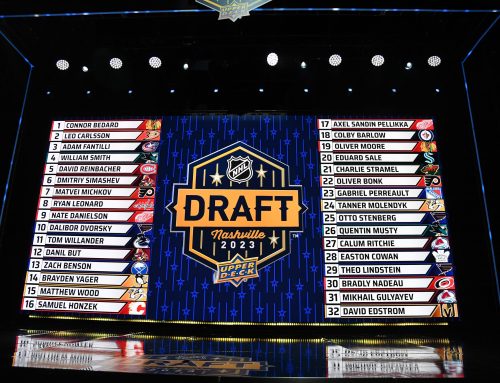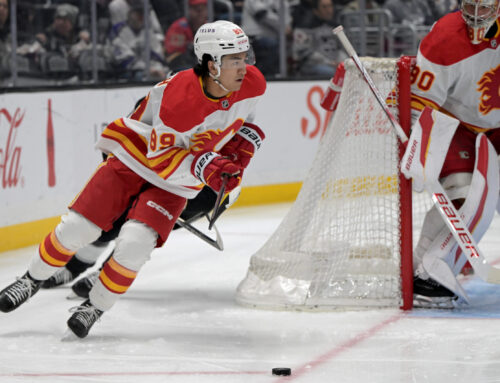Welcome back to The Journey, where we track the development of prospects as they excel in junior, make the NHL, and push towards stardom.
***
Sometimes results from statistical models like Hockey Prospecting can be baffling. How could Mikhail Gulyayev have a higher star potential than Adam Fantilli at the draft last year after Fantilli's historic NCAA season? Why did Zach Benson's star potential decline this year despite him making and holding his own in the NHL at 18 years old?
A common reaction to seeming inconsistencies like these is to disparage the value of the model itself. More helpful and interesting, though, is to treat these moments like puzzles. Interesting results in a model are a useful opportunity to revisit a player's fantasy value. Am I too high or too low on them? Is there something I have been missing about them? It is important to read around a model's results and consider some of the factors that it does not take into account: player size and skillset, team strength, linemates, deployment, and so on.
This week, we will revisit the star potential of the 2023 draft class using the Hockey Prospecting model. Even though it is too soon to say anything for sure given the small sample size of a single campaign, there have already been some interesting developments that warrant attention now that most leagues have wrapped up their regular seasons.
***
A quick reminder about what "star potential" means here: the HP model contextualizes a prospect's production by comparing it to what other players have accomplished in the same league at the same age. It defines an NHL "star" as a player who averages over 57 points (forward) or 37 points (defenceman) over their 200+-game pro career. That means a player could have a 65-point, star-level season but still fail to qualify as a star-level player.
So if a forward prospect scores 80 points in 65 games in the OHL in their Draft+1 year, the model will consider how many similarly aged prospects in the history of the OHL who produced at that level ended up making the NHL and become star-level producers. That number then becomes that prospect's "star potential."
This can help cut through the noise of junior-level production, which often seems more impressive than it actually is. As I point out all the time, age is king when it comes to star potential. The younger a prospect is when they hit certain benchmarks, the more likely they are to become an impactful scoring star once they make the NHL.
When a prospect's star potential seems unusually low, that is usually because they are older than most NHL stars were when they experienced a big jump in production. A bonafide star like John Tavares, for instance, was already scoring the lights out relative to his historical peers as a double-underager, whereas a B-level prospect like Adam Beckman (MIN) took home the WHL scoring title in his D+1 but had not blown the doors down prior to that.
Another common reason is a lack of historical comparables. When players like Moritz Seider make the show out of a more obscure league like the German DEL, the model doesn't really know how to contextualize their production and tends to penalize their star potential. As a result, more established leagues like the NCAA and OHL will tend to produce more realistic numbers.
***
With no further ado, here are the first ten players in the 2023 draft class ranked by Star Potential. The first number is their draft-year Star %, the second is where they stand now, and the parentheses show movement:
Matvei Michkov (PHI): 99 → 99 (0)
Connor Bedard (CHI): 99 → 99 (0)
Dalibor Dvorsky (STL): 54 → 80 (+26)
Mikhail Gulyayev (COL): 84 → 77 (-7)
Will Smith (SJS): 75 → 75 (0)
Adam Fantilli (CBJ): 77 → 72 (-5)
Ryan Leonard (WAS): 35 → 66 (+31)
Gavin Brindley (CBJ): 25 → 55 (+30)
Andrew Cristall (WAS): 59 → 52 (-7)
Riley Heidt (MIN): 41 → 49 (+7)
There were three main risers at the top of this class in 2023-24: Dvorsky, Leonard, and Brindley.
After spinning his gears at first over in Sweden, Dvorsky transitioned to North America in late October and exploded offensively in Sudbury (OHL) alongside Quentin Musty (SJS) and David Goyette (SEA). 45 goals in 52 games (plus 43 assists) is exactly the kind of production we would like to see from a 10th-overall pick.
But why did Dvorsky flame out after only ten games at Sweden's highest level?
In isolation, that development raises some red flags. But it seems more an issue of fit than anything. Oskarshamn had envisioned Dvorsky earning solid minutes by mid-season but they were floundering at the bottom of the standings early on and the young forward was not seeing the ice. In retrospect, maybe he should have re-upped in the 2nd-tier Allsvenskan this year instead of pushing to the SHL, but his results in the OHL speak for themselves. Here is a deeper dive on Dvorsky's decision from The Athletic.
I touched on Dvorsky's goal-scoring prowess in greater detail last week and Leonard and Brindley in early March. Long story short is that while Leonard and Brindley fell just short of having historic-level goal-scoring seasons in 2023-24, they posted very impressive results nonetheless. By goals per game, Leonard (0.74) and Brindley (0.66) finished alongside several impressive players at the same age who went on to star in the NHL: Thomas Vanek (0.69), Brian Gionta (0.75), Mike Cammalleri (0.69), Dany Heatley (0.74), and Brock Boeser (0.64). Leonard is going to be a star for Washington, and Brindley is shaping up into a dangerous complementary top-six player for the Blue Jackets.
Here is Leonard's wicked shot on display yesterday as he led Boston College over Michigan Tech in the NCAA tournament:
Returning to the list, I am not concerned about any of the six players who declined or stayed the same in this first group. Gulyayev is the main wildcard here, as his analytics profile is much stronger than his fantasy reputation at the moment. 12 points in 65 KHL games does not tell the whole story. This is an 18-year-old defender transitioning from junior to pro, playing big minutes right out of the gate and maintaining that deployment over an entire year. The points are just a bonus. He is a PP wizard type whose game is built on his impressive mobility and offensive instincts. If he can learn to defend against men, he will be more likely to earn that critical time with the man advantage when he crosses over to play with the Avalanche.
Gabe Perreault (NYR): 47 → 47 (0)
Quentin Musty (SJS): 19 → 45 (+26)
Bradly Nadeau (CAR): 19 → 45 (+26)
Lukas Dragicevic (SEA): 53 → 44 (-9)
Zach Benson (BUF): 68 → 43 (-25)
Oliver Moore (CHI): 53 → 37 (-16)
Luca Cagnoni (SJS): 16 → 31 (+15)
Denver Barkey (PHI): 19 → 29 (+10)
Calum Ritchie (COL): 22 → 28 (+6)
David Reinbacher (MTL): 37 → 27 (-10)
Big freshman years from Perreault (NYR) and Nadeau (CAR) in the NCAA. Perreault in particular continues to impress, putting up buckets of primary points wherever he goes. Props to public scouts like Scott Wheeler (Athletic) for planting their flag on him heading into the draft despite prevalent concerns that he was too slow, small, and riding the coattails of his linemates (Will Smith, Ryan Leonard).
Jake Guentzel would be an excellent outcome for the young man, though he is more of a playmaker than goal-scorer.
While it might be surprising to see Benson's star potential falling so dramatically (68 → 43) after making the show as an 18-year-old, his season did tail off a fair bit after he burst out of the gates in October with some flashy plays. Although his linemates, deployment, and overall ice time have been relatively solid, his power play time has dried up almost completely, and so have his shots. After taking 40 shots in 22 games in the second quarter of the season (1.8 per game), he regressed to only 35 over his next 29 (1.2). Growing pains are to be expected, of course, and Benson is still absolutely on a star trajectory for Buffalo.
Luca Cagnoni, Denver Barkey, and Calum Ritchie all acquitted themselves very nicely in junior this year.
Cagnoni (SJS) led all WHL defenders in scoring with a very impressive 90 points in only 65 games. That total bested the older, higher profile Denton Mateychuk (CBJ) at 75 in 52, though the Blue Jackets' prospect had a slight edge in points per game. As a fourth-round pick from only a year ago, these results are incredible and Sharks brass must be very excited. As a smaller (5-9), offensive-minded defender, he will constantly have to answer questions about his defending, but the offensive side of things is clearly alive and well.
Barkey (PHI) finished fifth in OHL scoring with 102 points in 64 games, pulling off another trademark London Knights D+1 year explosion. He lacks that one elite tool that the best offensive players have, but his skill set is average to above-average across the board. I read a Logan Stankoven comparison for Barkey in his draft year from someone in the scouting community and have not been able to get that out of my head. I don't know their respective games well enough to take that much further yet, but the way Barkey loses himself in the slot and rips this home certainly looks a bit Stank-y to me.
The main complaint with Ritchie in his draft year was that his tools outstripped his production. Point-per-game scoring as an OHL draft-eligible just doesn't scream "early first-round pick," but the Avs clearly snagged a steal, getting him and Gulyayev at the tail end of the first. Ritchie finished just outside the top 20 in OHL scoring this year with 80 points in 50 games—a total more in line with his pedigree. But unlike Barkey, who had a ton of NHL-level support with London, Ritchie basically had to put Oshawa on his back this year. The fact that the Generals finished first in the East with only three other NHL-drafted prospects (all relative no-names) is a testament to how impactful he can be.
Reinbacher's up-and-down season has been well-documented. Check out Hadi's recent take over at Habs Eyes on the Prize for an excellent overview. Montreal taking him at fifth overall with Michkov still on the board will always be controversial, but he is continuing to develop positively into an impactful top-four blueliner—despite being in a less-than-ideal environment over in Switzerland for most of the year.
Oliver Moore (CHI) and linemate Jimmy Snuggerud (STL) for Minnesota recently advanced in the NCAA tournament after a thrilling win over Omaha. Known for his s-tier skating ability, Moore was tricky to evaluate in his draft year relative to the other three big names on the '23 NTDP (Smith, Perreault, Leonard), especially because he held down the second line while the others grabbed the glory together on the first line. Nevertheless, outlets like Dobber Prospects and Elite Prospects were very high on him: DP switched Moore (7th) and Smith (6th) at the last minute in our final rankings, keeping Moore above Leonard (10th) and Perreault (24th), while EP went with Leonard (6th), Smith (7th), Moore (8th), and Perreault (18th).
Although Moore's D+1 lagged behind those from the "Big Three," his 33 points in 38 games as a freshman is still an excellent campaign. While he has taken a step back in 2023-24 in terms of historical trajectory, Moore continues to be a high-end prospect—roughly comparable in value to a player like Snuggerud—with an absolutely loaded skill-set.
***
Thanks for reading! Tune in next week for analysis on the next half of the 2023 draft, including Leo Carlsson (ANA), Nick Lardis (CHI), Colby Barlow (WPG), Matthew Wood (NAS), Easton Cowan (TOR), and Nate Danielson (DET). Follow me on X @beegare for more prospect content and fantasy hockey analysis.





 EDM
EDM FLA
FLA MIN
MIN NSH
NSH PIT
PIT UTA
UTA CHI
CHI VGK
VGK
